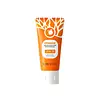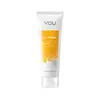What's inside
What's inside
 Key Ingredients
Key Ingredients

 Benefits
Benefits

 Concerns
Concerns

 Ingredients Side-by-side
Ingredients Side-by-side

Water
Skin ConditioningCarbomer
Emulsion StabilisingDipropylene Glycol
HumectantDodecylbenzyltrimonium Chloride
AntimicrobialPEG-40 Hydrogenated Castor Oil
EmulsifyingParfum
MaskingEthylhexylglycerin
Skin ConditioningLactose
HumectantCitrus Aurantium Dulcis Peel Oil
MaskingLactobacillus/Milk Ferment Filtrate
Skin ConditioningPseudoalteromonas Ferment Extract
HumectantBacillus
Skin ConditioningNiacinamide
Smoothing3-O-Ethyl Ascorbic Acid
Skin ConditioningGlutathione
Pearl Extract
AntioxidantSalicylic Acid
MaskingHamamelis Virginiana Water
AstringentGlycolic Acid
BufferingLactic Acid
BufferingSea Salt
AbrasiveJojoba Esters
EmollientTitanium Dioxide
Cosmetic ColorantTocopheryl Acetate
AntioxidantAscorbyl Palmitate
AntioxidantCarnosine
Skin ConditioningGlycyrrhiza Glabra Root
Skin ConditioningFolic Acid
Skin ConditioningCynanchum Atratum Extract
Skin ConditioningCeramide As
Skin ConditioningCeramide Ns
Skin ConditioningCeramide AP
Skin ConditioningCeramide EOP
Skin ConditioningSodium Hyaluronate
HumectantCellulose
AbsorbentMicrocrystalline Cellulose
AbsorbentCI 77891
Cosmetic ColorantCI 77499
Cosmetic ColorantMannitol
HumectantHydroxypropyl Methylcellulose
Emulsion StabilisingHydrogenated Lecithin
EmulsifyingZea Mays Starch
AbsorbentDisodium EDTA
Mica
Cosmetic ColorantEthylcellulose
PEG-150
HumectantCI 77492
Cosmetic ColorantAcrylates/C10-30 Alkyl Acrylate Crosspolymer
Emulsion StabilisingPhenoxyethanol
PreservativeButylene Glycol
Humectant1,2-Hexanediol
Skin ConditioningMethylparaben
PreservativeCaprylyl Glycol
EmollientGlycerin
HumectantPentylene Glycol
Skin ConditioningWater, Carbomer, Dipropylene Glycol, Dodecylbenzyltrimonium Chloride, PEG-40 Hydrogenated Castor Oil, Parfum, Ethylhexylglycerin, Lactose, Citrus Aurantium Dulcis Peel Oil, Lactobacillus/Milk Ferment Filtrate, Pseudoalteromonas Ferment Extract, Bacillus, Niacinamide, 3-O-Ethyl Ascorbic Acid, Glutathione, Pearl Extract, Salicylic Acid, Hamamelis Virginiana Water, Glycolic Acid, Lactic Acid, Sea Salt, Jojoba Esters, Titanium Dioxide, Tocopheryl Acetate, Ascorbyl Palmitate, Carnosine, Glycyrrhiza Glabra Root, Folic Acid, Cynanchum Atratum Extract, Ceramide As, Ceramide Ns, Ceramide AP, Ceramide EOP, Sodium Hyaluronate, Cellulose, Microcrystalline Cellulose, CI 77891, CI 77499, Mannitol, Hydroxypropyl Methylcellulose, Hydrogenated Lecithin, Zea Mays Starch, Disodium EDTA, Mica, Ethylcellulose, PEG-150, CI 77492, Acrylates/C10-30 Alkyl Acrylate Crosspolymer, Phenoxyethanol, Butylene Glycol, 1,2-Hexanediol, Methylparaben, Caprylyl Glycol, Glycerin, Pentylene Glycol
Water
Skin ConditioningSodium Laureth Sulfate
CleansingCocamidopropyl Betaine
CleansingSodium Lauryl Sulfate
CleansingSekken Soji
CleansingSodium Chloride
MaskingGlycol Distearate
EmollientDecyl Glucoside
CleansingPhenoxyethanol
PreservativeDistearyl Phthalic Acid Amide
EmollientSodium Benzoate
MaskingPotassium Laureth Phosphate
EmulsifyingPEG-40 Hydrogenated Castor Oil
EmulsifyingCocamide Mea
EmulsifyingAcrylates Copolymer
PEG-120 Methyl Glucose Dioleate
EmulsifyingGlycerin
HumectantCaprylic/Capric Triglyceride
MaskingCitric Acid
BufferingDisodium EDTA
Citrus Limon Fruit Oil
AstringentCitrus Tangerina Peel Oil
MaskingCitrus Aurantium Dulcis Peel Oil
MaskingNiacinamide
SmoothingButylene Glycol
Humectant3-O-Ethyl Ascorbic Acid
Skin ConditioningHyaluronic Acid
HumectantPentylene Glycol
Skin ConditioningMoringa Oleifera Seed Extract
Skin ConditioningHistidine
HumectantSerine
MaskingCamellia Japonica Flower Extract
EmollientThreonine
Aspartic Acid
MaskingSodium Acetylated Hyaluronate
HumectantSodium Hyaluronate
Humectant1,2-Hexanediol
Skin ConditioningSodium Hyaluronate Crosspolymer
HumectantHydroxyacetophenone
AntioxidantHydrolyzed Sodium Hyaluronate
Skin ConditioningEthylhexylglycerin
Skin ConditioningWater, Sodium Laureth Sulfate, Cocamidopropyl Betaine, Sodium Lauryl Sulfate, Sekken Soji, Sodium Chloride, Glycol Distearate, Decyl Glucoside, Phenoxyethanol, Distearyl Phthalic Acid Amide, Sodium Benzoate, Potassium Laureth Phosphate, PEG-40 Hydrogenated Castor Oil, Cocamide Mea, Acrylates Copolymer, PEG-120 Methyl Glucose Dioleate, Glycerin, Caprylic/Capric Triglyceride, Citric Acid, Disodium EDTA, Citrus Limon Fruit Oil, Citrus Tangerina Peel Oil, Citrus Aurantium Dulcis Peel Oil, Niacinamide, Butylene Glycol, 3-O-Ethyl Ascorbic Acid, Hyaluronic Acid, Pentylene Glycol, Moringa Oleifera Seed Extract, Histidine, Serine, Camellia Japonica Flower Extract, Threonine, Aspartic Acid, Sodium Acetylated Hyaluronate, Sodium Hyaluronate, 1,2-Hexanediol, Sodium Hyaluronate Crosspolymer, Hydroxyacetophenone, Hydrolyzed Sodium Hyaluronate, Ethylhexylglycerin
 Reviews
Reviews

Ingredients Explained
These ingredients are found in both products.
Ingredients higher up in an ingredient list are typically present in a larger amount.
1,2-Hexanediol is a synthetic liquid and another multi-functional powerhouse.
It is a:
- Humectant, drawing moisture into the skin
- Emollient, helping to soften skin
- Solvent, dispersing and stabilizing formulas
- Preservative booster, enhancing the antimicrobial activity of other preservatives
You might know this ingredient as Ethyl Ascorbic Acid, a more stable version of ascorbic acid.
Like other types of vitamin C, this ingredient has many benefits including reducing wrinkles, skin soothing, dark spot fading, and fighting against free radicals.
3-O-Ethyl Ascorbic Acid interferes with the process of skin darkening, helping to reduce hyperpigmentation. It also encourages the skin to produce more collagen.
Once applied, 3-O-Ethyl Ascorbic Acid is converted to Vitamin C deeper in the skin's layers. This process is slow but makes this ingredient more tolerable for skin.
The optimum pH range for this ingredient is 4 - 5.5
Learn more about 3-O-Ethyl Ascorbic AcidButylene Glycol (or BG) is used within cosmetic products for a few different reasons:
Overall, Butylene Glycol is a safe and well-rounded ingredient that works well with other ingredients.
Though this ingredient works well with most skin types, some people with sensitive skin may experience a reaction such as allergic rashes, closed comedones, or itchiness.
Learn more about Butylene GlycolCitrus Aurantium Dulcis Peel Oil is oil from the peel of an orange fruit.
Limonene and linalool make up the majority of oils from citrus peels. Limonene has a "citrus" fragrance. Citrus peels also contain flavonoids, which have anti-inflammatory properties.
Citrus peel is also a rich source of flavonoids. Flavonoids are natural antioxidants and help protect your skin against damage. Flavonoids are a group of compounds naturally found in vegetables and fruits.
The term 'fragrance' is not regulated in many countries. In many cases, it is up to the brand to define this term. For instance, many brands choose to label themselves as "fragrance-free" because they are not using synthetic fragrances. However, their products may still contain ingredients such as essential oils that are considered a fragrance.
Learn more about Citrus Aurantium Dulcis Peel OilDisodium EDTA plays a role in making products more stable by aiding other preservatives.
It is a chelating agent, meaning it neutralizes metal ions that may be found in a product.
Disodium EDTA is a salt of edetic acid and is found to be safe in cosmetic ingredients.
Learn more about Disodium EDTAEthylhexylglycerin (we can't pronounce this either) is commonly used as a preservative and skin softener. It is derived from glyceryl.
You might see Ethylhexylglycerin often paired with other preservatives such as phenoxyethanol. Ethylhexylglycerin has been found to increase the effectiveness of these other preservatives.
Glycerin is already naturally found in your skin. It helps moisturize and protect your skin.
A study from 2016 found glycerin to be more effective as a humectant than AHAs and hyaluronic acid.
As a humectant, it helps the skin stay hydrated by pulling moisture to your skin. The low molecular weight of glycerin allows it to pull moisture into the deeper layers of your skin.
Hydrated skin improves your skin barrier; Your skin barrier helps protect against irritants and bacteria.
Glycerin has also been found to have antimicrobial and antiviral properties. Due to these properties, glycerin is often used in wound and burn treatments.
In cosmetics, glycerin is usually derived from plants such as soybean or palm. However, it can also be sourced from animals, such as tallow or animal fat.
This ingredient is organic, colorless, odorless, and non-toxic.
Glycerin is the name for this ingredient in American English. British English uses Glycerol/Glycerine.
Learn more about GlycerinNiacinamide is a multitasking form of vitamin B3 that strengthens the skin barrier, reduces pores and dark spots, regulates oil, and improves signs of aging.
And the best part? It's gentle and well-tolerated by most skin types, including sensitive and reactive skin.
You might have heard of "niacin flush", or the reddening of skin that causes itchiness. Niacinamide has not been found to cause this.
In very rare cases, some individuals may not be able to tolerate niacinamide at all or experience an allergic reaction to it.
If you are experiencing flaking, irritation, and dryness with this ingredient, be sure to double check all your products as this ingredient can be found in all categories of skincare.
When incorporating niacinamide into your routine, look out for concentration amounts. Typically, 5% niacinamide provides benefits such as fading dark spots. However, if you have sensitive skin, it is better to begin with a smaller concentration.
When you apply niacinamide to your skin, your body converts it into nicotinamide adenine dinucleotide (NAD). NAD is an essential coenzyme that is already found in your cells as "fuel" and powers countless biological processes.
In your skin, NAD helps repair cell damage, produce new healthy cells, support collagen production, strengthen the skin barrier, and fight environmental stressors (like UV and pollution).
Our natural NAD levels start to decline with age, leading to slower skin repair, visible aging, and a weaker skin barrier. By providing your skin niacinamide, you're recharging your skin's NAD levels. This leads to stronger, healthier, and younger looking skin.
Another name for vitamin B3 is nicotinamide. This vitamin is water-soluble and our bodies don't store it. We obtain Vitamin B3 from either food or skincare. Meat, fish, wheat, yeast, and leafy greens contain vitamin B3.
The type of niacinamide used in skincare is synthetically created.
Learn more about NiacinamidePeg-40 Hydrogenated Castor Oil is derived from castor oil and polyethylene glycol (PEG). It is used as a emollient and emulsifier.
As an emulsifier, it helps prevent ingredients from separating. It also helps make the other ingredients more soluble; it is often used to solubilize fragrances. This increases spreadability and elongates shelf life in a product.
Emollients help soothe and soften the skin. They do this by creating a protective film on your skin. This barrier helps trap moisture and keeps your skin hydrated. Emollients may be effective at treating dry or itchy skin.
This ingredient may or may not be vegan, depending on the source.
Peg-40 Hydrogenated Castor Oil may not be fungal-acne safe. We recommend speaking with a professional if you have any questions or concerns.
Learn more about PEG-40 Hydrogenated Castor OilPentylene glycol is typically used within a product to thicken it. It also adds a smooth, soft, and moisturizing feel to the product. It is naturally found in plants such as sugar beets.
The hydrophilic trait of Pentylene Glycol makes it a humectant. As a humectant, Pentylene Glycol helps draw moisture from the air to your skin. This can help keep your skin hydrated.
This property also makes Pentylene Glycol a great texture enhancer. It can also help thicken or stabilize a product.
Pentylene Glycol also acts as a mild preservative and helps to keep a product microbe-free.
Some people may experience mild eye and skin irritation from Pentylene Glycol. We always recommend speaking with a professional about using this ingredient in your routine.
Pentylene Glycol has a low molecular weight and is part of the 1,2-glycol family.
Learn more about Pentylene GlycolPhenoxyethanol is a preservative that has germicide, antimicrobial, and aromatic properties. Studies show that phenoxyethanol can prevent microbial growth. By itself, it has a scent that is similar to that of a rose.
It's often used in formulations along with Caprylyl Glycol to preserve the shelf life of products.
Sodium Hyaluronate is hyaluronic acid's salt form. It is commonly derived from the sodium salt of hyaluronic acid.
Like hyaluronic acid, it is great at holding water and acts as a humectant. This makes it a great skin hydrating ingredient.
Sodium Hyaluronate is naturally occurring in our bodies and is mostly found in eye fluid and joints.
These are some other common types of Hyaluronic Acid:
Learn more about Sodium HyaluronateWater. It's the most common cosmetic ingredient of all. You'll usually see it at the top of ingredient lists, meaning that it makes up the largest part of the product.
So why is it so popular? Water most often acts as a solvent - this means that it helps dissolve other ingredients into the formulation.
You'll also recognize water as that liquid we all need to stay alive. If you see this, drink a glass of water. Stay hydrated!
Learn more about Water